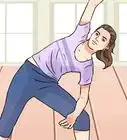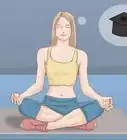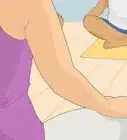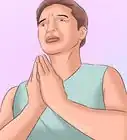This article was co-authored by Elaine Oyang. Elaine Oyang is a Yoga Therapist and Instructor, Wellness Advocate, and Founder of Elaine Oyang Yoga in the San Francisco Bay Area. With over 9 years of experience, Elaine specializes in spinal release yoga, viniyoga, pranayama (yoga breathing practices), meditation, guided relaxation, and Ayurveda. Elaine holds a BS in Biology from Harvey Mudd College. She is certified in Yoga Therapy from the Stress Management Center of Marin. Elaine has received over 1,000 hours of training in yoga therapy and focuses on teaching clients to redirect stress and tensions towards effective self-growth, resilience, and contentment through physical nurturing and inner reflection. She also specializes in treating those with Fibromyalgia, chronic pain, chronic fatigue, Lupus, Lyme's, anxiety, and depression.
There are 7 references cited in this article, which can be found at the bottom of the page.
This article has been viewed 87,058 times.
If you have lower back pain, you may find it harder to perform everyday tasks that involve lifting, bending, reaching, or even merely walking. Fortunately, there are a few stretches specific to yoga that you can use to loosen up the muscles in your lower back and to relieve pain. Relaxing your lower-back muscles will help you feel less tension in the sore muscles and will give your body a chance to heal any damaged tissue. Regardless of which stretches you choose, perform them wearing loose-fitting clothing and on soft carpet or a yoga mat.
Steps
Trying the Cat and Cow Pose
-
1Get on your hands and knees on a yoga mat. Plant your hands firmly on the ground and keep them shoulder-width apart. Make sure your knees are directly underneath your hips and your hands are underneath your shoulders, so your body will be as stable as possible.[1]
- Straighten your elbows and bend them as little as possible during this exercise. Also, avoid moving your hips side to side or leaning towards one direction or the other.[2]
- If you find that this yoga pose hurts your knees, try wearing a pair of plastic knee pads.
-
2Inhale and lift your chest and rear end up towards the ceiling. Relax the muscles in your lower back and in your stomach so gravity can pull the middle of your torso downward. Lift up your tailbone and butt, and bend your neck back to elevate your upper chest. You should feel the muscles between your shoulder blades and at the base of your spine stretch as you’re getting into position.[3]Advertisement
-
3Switch poses by exhaling and arching the center of your back. Drop your head and your butt as you breathe out to return to a neutral pose. As you continue to exhale, arch the middle of your back up towards the ceiling. Imagine that you’re pressing your shoulder blades upwards as you arch your back. Tuck your rear end in under your hips, and bring your hips slightly forwards towards your stomach.[6]
- This is the “cow” part of the yoga exercise. The majority of the benefits to your back come from switching back and forth between the positions.
- Only stretch as far as you're comfortable. Do not strain.[7]
-
4Alternate between the cat and cow positions 6-8 times. Move at a pace that feels natural to you based on the speed of your breath. For example, if you inhale for 8 seconds, hold the “cat” position for that amount of time. Then move into the “cow” position in 1-2 seconds and hold the pose during your 8-second exhale.[8]
- By alternating between arching and bending your back, you’ll work out tension in your lower-back muscles. This pose is also a great way to stretch (and relieve tension in) your hips and to loosen up your spine.
-
5Try a seated variation of cat-cow to stretch at work. Sit at the edge of your chair and put your hands on your thighs. Plant your feet on the floor, then inhale deeply. As you do that, arch your back so you lift your chest and ribcage upward. When you exhale, come downwards, slightly rounding your back as you tuck your chin toward your chest.[9]
- Repeat this 8-10 times.
- Get a full stretch by leaning sideways over the arms of your chair after you do this.[10]
Getting into Sphinx Position
-
1Lay flat on your stomach with your feet hip-width apart. Use a yoga mat or other soft surface and recline on your front. You can either point your feet so your toes point away from your body or set your feet vertically so that the weight of each foot balances on your longest 2-3 toes.[11]
- The sphinx pose is great for your lower back, especially if you spend a lot of your time sitting at a desk or office chair. The pose helps your spine and lower back keep its natural curvature.
-
2Bend your arms and draw your elbows up under your shoulders. Tighten your back muscles to lift up your torso off of the ground. Pull your elbows back until they’re bent at a 90-degree angle, directly beneath your shoulders. Rest the weight of your torso on your elbows, and keep your back arched to stretch sore muscles in your lower back. Keep your hips flat against the ground.[12]
- If you’re new to yoga and find this pose a little too demanding, move your elbows forward by about 3–4 inches (7.6–10.2 cm) so that they’re not directly under your shoulders.
-
3Breathe slowly and deeply as you hold the sphinx pose. Breathing is crucial during any yoga pose and especially important during a position that’s stretching out a painful area of your body. Focus on deeply inhaling and exhaling as you draw up your elbows and prop your torso on your arms. This will help your muscles relax and so you don’t accidentally strain a muscle in your back.[13]
- When you breathe in and out, imagine that you’re letting go of tension in your lower back with each breathe that you exhale.
-
4Hold the sphinx pose for 1-3 minutes before relaxing. Holding the pose will allow your spine to relax and bend and will stretch out the muscles in your middle and lower back. To relax from the sphinx pose, lower your torso down to the floor with your elbows still bent. Then move your arms to the side and straighten your elbows.[14]
- If you have a weak back, sphinx pose can be pretty tiring. Lay on the floor for as long as you need to before moving on to your next pose.
Doing a Supine Twist
-
1Lay flat on your back and pull your right knee to your chest. Recline on a comfortable surface, like a yoga mat or plush carpet. Lift your right knee up towards the right side of your chest as far as it will go. When your knee is fully bent, reach down with both hands and interlace all of your fingers in front of your shin to hold your knee up. Hold this position for 20-30 seconds.[15]
- The supine twist is a great yoga position for gently stretching out your gluteus muscles and relieving tension in your lower back.
-
2Cross your right knee over to the left side of your body. Release your shin and move your right leg over to the left side of your body by rolling your hips to the left. Roll your hips until your right hip is above your left, as if they were “stacked” on top of one another. Keep your shoulders flat on the ground while you’re doing this.[16]
- Deep breaths help loosen your body and relax the muscles in your lower back. It may help if you deeply exhale while moving your leg and rolling your hips.
-
3Extend your right arm straight out on the right side of your body. Keep your hips stacked on top of one another and reach out to the right with your right arm. Hold your arm so that your palm faces upward. As you extend your arm out, you’ll feel your gluteus muscles stretch. Your lower back should twist and stretch out in a way that relieves pain.[17]
- It will help you keep your shoulders flat on the ground if you look upwards (towards the ceiling) or to the right (towards your extended hand).
-
4Take 10 deep, slow breaths while holding this position. Keep your right shoulder flat against the ground, your right arm extended, and your right leg crossed over your left with your hips stacked on top of one another. Count your breaths; each one should take 5-6 seconds. Once you’ve inhaled and exhaled 10 times, draw your right arm in and return your right hip to the ground.[18]
- Once you’ve stretched with your right leg, repeat the stretch on the other side of your body. Bring your left knee up to your chest and then roll so your left hip is over your right hip.
Stretching with Modified Downward Dog
-
1Stand with your feet 2 ft (0.61 m) apart and bend forward. Bend at the waist until you’re leaning forward by about 30 degrees. Focus on bending from the hips rather than from the lower back. If it helps, try sticking your butt out as you bend to make sure you’re engaging your hips.[19]
- If you have narrower shoulders, you can bring your feet together by a few inches. Try to keep your feet shoulder-width apart, but you should still feel comfortable and stable.[20]
-
2Lean forward farther to stretch muscles in your lower back. Relax the muscles keeping you upright so that your torso folds forward and your head approaches the ground. Stretch your arms out in front of you while you’re leaning; their weight will help pull your torso down and stretch out your lower back. If you’re flexible (or do yoga regularly), you may even be able to rest your fingertips on the ground.[21]
- This pose is pretty similar to downward facing dog, except that your weight is entirely on your feet, rather than being balanced between feet and hands.
- If you find that it’s too uncomfortable to keep your legs perfectly straight, try bending your knees slightly. This will take some pressure off your hamstrings and lower back and should make the stretch a little easier.
-
3Relax your shoulders and tuck in your chin as you lean forward. Relax your shoulders as you continue to lean forward from your hips. It might help you stretch farther if you imagine stretching the top of your head farther down towards the floor. The idea is to lengthen your spine by bending your chin towards your chest. Focus on breathing slowly and deeply while you’re stretching your body into this position. You should feel your back muscles relax with every breath that you exhale.[22]
- Stretching out your spine will stretch out the tense muscles in your lower back and should reduce pain.
-
4Hold the position for 1-3 minutes before standing up. As you’re holding the pose, you should be able to feel your spine and lengthening and the backs of your legs stretching out. Once the 1-3 minutes have passed, slowly engage your back muscles and return to a standing position.[23]
- Take several slow, very deep breaths as you do this.Each time you exhale, try to relax and go a little deeper into the stretch.[24]
Expert Q&A
-
QuestionAre there any good stretches for back pain due to sitting all day?
 Pasquale Antonio, CPT, RYT-500Pasquale Antonio is a Martial Artist, Yoga Instructor, Fitness Instructor, and the Founder of Jiyu, a holistic approach to health and movement practices. Pasquale is also the assistant instructor at NC Systema in Durham, North Carolina. Utilizing the principles of Eastern principles of yoga, internal martial arts, bodywork, and Western principles of exercise and behavioral sciences, Pasquale helps students of all ages cultivate their long-term health, creativity, and personal goals. Pasquale is a Certified Personal Trainer by the National Academy of Sports Medicine (NASM), a Certified Systema Instructor, a Certified Yoga Instructor, and a Certified Authentic Thai (MAT) Massage Practitioner.
Pasquale Antonio, CPT, RYT-500Pasquale Antonio is a Martial Artist, Yoga Instructor, Fitness Instructor, and the Founder of Jiyu, a holistic approach to health and movement practices. Pasquale is also the assistant instructor at NC Systema in Durham, North Carolina. Utilizing the principles of Eastern principles of yoga, internal martial arts, bodywork, and Western principles of exercise and behavioral sciences, Pasquale helps students of all ages cultivate their long-term health, creativity, and personal goals. Pasquale is a Certified Personal Trainer by the National Academy of Sports Medicine (NASM), a Certified Systema Instructor, a Certified Yoga Instructor, and a Certified Authentic Thai (MAT) Massage Practitioner.
Martial Artist, Yoga, & Fitness Instructor There are a number of easy stretches that are fairly safe for anyone to do. For instance, simply raising your arms up above your head can open up your chest and back, which can help alleviate pain right away.
There are a number of easy stretches that are fairly safe for anyone to do. For instance, simply raising your arms up above your head can open up your chest and back, which can help alleviate pain right away. -
QuestionAre there any yoga exercises I can do for back pain when I'm at work?
 Elaine OyangElaine Oyang is a Yoga Therapist and Instructor, Wellness Advocate, and Founder of Elaine Oyang Yoga in the San Francisco Bay Area. With over 9 years of experience, Elaine specializes in spinal release yoga, viniyoga, pranayama (yoga breathing practices), meditation, guided relaxation, and Ayurveda. Elaine holds a BS in Biology from Harvey Mudd College. She is certified in Yoga Therapy from the Stress Management Center of Marin. Elaine has received over 1,000 hours of training in yoga therapy and focuses on teaching clients to redirect stress and tensions towards effective self-growth, resilience, and contentment through physical nurturing and inner reflection. She also specializes in treating those with Fibromyalgia, chronic pain, chronic fatigue, Lupus, Lyme's, anxiety, and depression.
Elaine OyangElaine Oyang is a Yoga Therapist and Instructor, Wellness Advocate, and Founder of Elaine Oyang Yoga in the San Francisco Bay Area. With over 9 years of experience, Elaine specializes in spinal release yoga, viniyoga, pranayama (yoga breathing practices), meditation, guided relaxation, and Ayurveda. Elaine holds a BS in Biology from Harvey Mudd College. She is certified in Yoga Therapy from the Stress Management Center of Marin. Elaine has received over 1,000 hours of training in yoga therapy and focuses on teaching clients to redirect stress and tensions towards effective self-growth, resilience, and contentment through physical nurturing and inner reflection. She also specializes in treating those with Fibromyalgia, chronic pain, chronic fatigue, Lupus, Lyme's, anxiety, and depression.
Yoga Therapist & Instructor Try sitting on the edge of your chair with your feet planted on the floor. Rest your hands on your thighs, then inhale and arch your back so you're lifting your ribcage. Then, round your chest forward as you exhale. Do this 8-10 times.
Try sitting on the edge of your chair with your feet planted on the floor. Rest your hands on your thighs, then inhale and arch your back so you're lifting your ribcage. Then, round your chest forward as you exhale. Do this 8-10 times. -
QuestionWhat's a gentle stretch I can do for back pain?
 Elaine OyangElaine Oyang is a Yoga Therapist and Instructor, Wellness Advocate, and Founder of Elaine Oyang Yoga in the San Francisco Bay Area. With over 9 years of experience, Elaine specializes in spinal release yoga, viniyoga, pranayama (yoga breathing practices), meditation, guided relaxation, and Ayurveda. Elaine holds a BS in Biology from Harvey Mudd College. She is certified in Yoga Therapy from the Stress Management Center of Marin. Elaine has received over 1,000 hours of training in yoga therapy and focuses on teaching clients to redirect stress and tensions towards effective self-growth, resilience, and contentment through physical nurturing and inner reflection. She also specializes in treating those with Fibromyalgia, chronic pain, chronic fatigue, Lupus, Lyme's, anxiety, and depression.
Elaine OyangElaine Oyang is a Yoga Therapist and Instructor, Wellness Advocate, and Founder of Elaine Oyang Yoga in the San Francisco Bay Area. With over 9 years of experience, Elaine specializes in spinal release yoga, viniyoga, pranayama (yoga breathing practices), meditation, guided relaxation, and Ayurveda. Elaine holds a BS in Biology from Harvey Mudd College. She is certified in Yoga Therapy from the Stress Management Center of Marin. Elaine has received over 1,000 hours of training in yoga therapy and focuses on teaching clients to redirect stress and tensions towards effective self-growth, resilience, and contentment through physical nurturing and inner reflection. She also specializes in treating those with Fibromyalgia, chronic pain, chronic fatigue, Lupus, Lyme's, anxiety, and depression.
Yoga Therapist & Instructor Lie on the floor and put your shins, calves, and feet on a chair or couch. Stay there and let your body relax for a couple of minutes, then bring both of your knees in and curl up on your side in the fetal position. Hold that for up to 5 minutes, breathing naturally.
Lie on the floor and put your shins, calves, and feet on a chair or couch. Stay there and let your body relax for a couple of minutes, then bring both of your knees in and curl up on your side in the fetal position. Hold that for up to 5 minutes, breathing naturally.
Warnings
- If you feel any pain more serious than light muscle strain while doing yoga, stop immediately.⧼thumbs_response⧽
- It’s possible for yoga novices to harm themselves when performing a new stretch or pose. Avoid hurting yourself by moving into each position slowly, giving your body time to adjust to the position.[25]⧼thumbs_response⧽
- Adults over 60 should talk with their doctor to make sure they’re healthy enough to perform yoga. Also, anyone with a spinal fracture or a slipped disc should avoid doing yoga of any kind.[26]⧼thumbs_response⧽
References
- ↑ Pasquale Antonio, CPT, RYT-500. Martial Artist, Yoga, & Fitness Instructor. Expert Interview. 8 May 2020.
- ↑ https://www.doyouyoga.com/5-yoga-poses-to-ease-lower-back-pain-30237/
- ↑ Elaine Oyang. Yoga Therapist & Instructor. Expert Interview. 10 September 2020.
- ↑ Elaine Oyang. Yoga Therapist & Instructor. Expert Interview. 10 September 2020.
- ↑ Pasquale Antonio, CPT, RYT-500. Martial Artist, Yoga, & Fitness Instructor. Expert Interview. 8 May 2020.
- ↑ https://www.doyouyoga.com/5-yoga-poses-to-ease-lower-back-pain-30237/
- ↑ Pasquale Antonio, CPT, RYT-500. Martial Artist, Yoga, & Fitness Instructor. Expert Interview. 8 May 2020.
- ↑ https://www.doyouyoga.com/5-yoga-poses-to-ease-lower-back-pain-30237/
- ↑ Elaine Oyang. Yoga Therapist & Instructor. Expert Interview. 10 September 2020.
- ↑ Elaine Oyang. Yoga Therapist & Instructor. Expert Interview. 10 September 2020.
- ↑ https://www.doyouyoga.com/5-yoga-poses-to-ease-lower-back-pain-30237/
- ↑ https://www.doyouyoga.com/5-yoga-poses-to-ease-lower-back-pain-30237/
- ↑ http://www.yogabasics.com/asana/sphinx/
- ↑ https://www.doyouyoga.com/5-yoga-poses-to-ease-lower-back-pain-30237/
- ↑ https://www.outsideonline.com/2336626/lower-back-pain-stretches
- ↑ https://www.outsideonline.com/2336626/lower-back-pain-stretches
- ↑ https://www.outsideonline.com/2336626/lower-back-pain-stretches
- ↑ https://www.outsideonline.com/2336626/lower-back-pain-stretches
- ↑ https://www.self.com/gallery/yoga-poses-to-relieve-lower-back-pain
- ↑ Pasquale Antonio, CPT, RYT-500. Martial Artist, Yoga, & Fitness Instructor. Expert Interview. 8 May 2020.
- ↑ https://www.self.com/gallery/yoga-poses-to-relieve-lower-back-pain
- ↑ https://www.self.com/gallery/yoga-poses-to-relieve-lower-back-pain
- ↑ https://www.self.com/gallery/yoga-poses-to-relieve-lower-back-pain
- ↑ Pasquale Antonio, CPT, RYT-500. Martial Artist, Yoga, & Fitness Instructor. Expert Interview. 8 May 2020.
- ↑ https://www.health.harvard.edu/staying-healthy/the-safe-way-to-do-yoga-for-back-pain
- ↑ https://www.health.harvard.edu/staying-healthy/the-safe-way-to-do-yoga-for-back-pain
About This Article
If you’re suffering from lower back pain, there are various yoga stretches that can bring you relief. Alternating between the cat and cow poses will target your sore back. Start on your hands and knees on the ground. Then, inhale and lift your chest and rear towards the ceiling for the cat pose. As you exhale, drop your head and rear, then arch the middle of your back towards the floor for the cow pose. Alternate between the cat and cow 6 to 8 times, holding each pose for a couple of seconds. You can also try the sphinx pose, which involves lying flat on your stomach with your feet apart, then bending your elbows directly beneath your shoulders and arching your back. Breathe slowly and hold the pose for a couple of minutes. For more tips, including how to do a downward dog pose to help your back pain, read on!
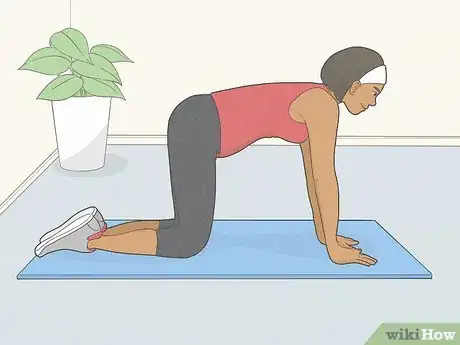

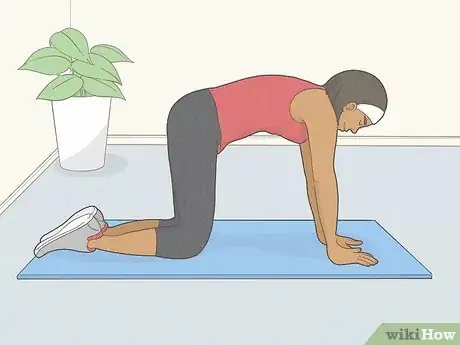

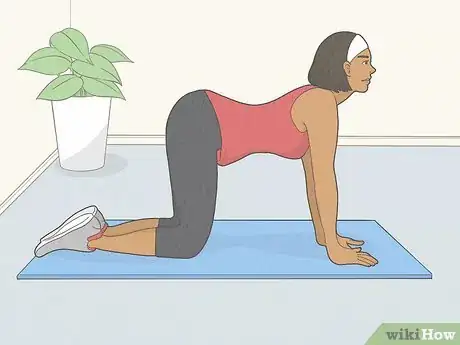
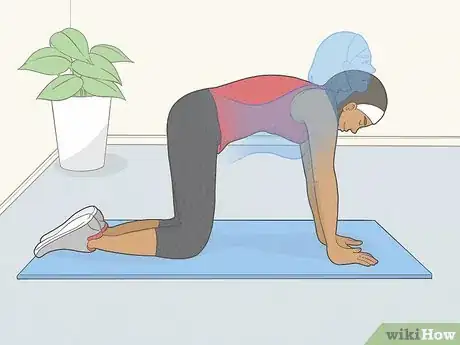
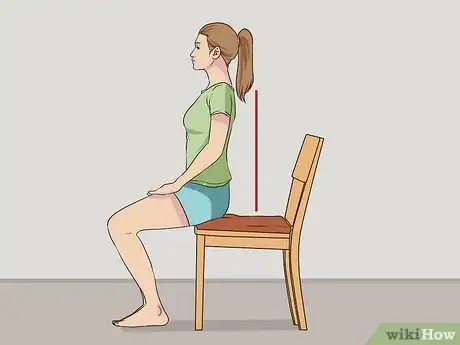
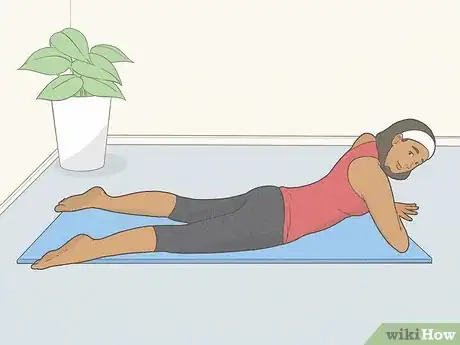
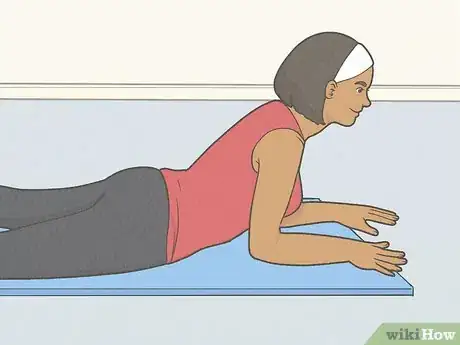
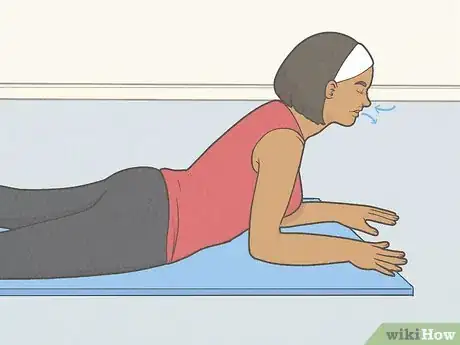
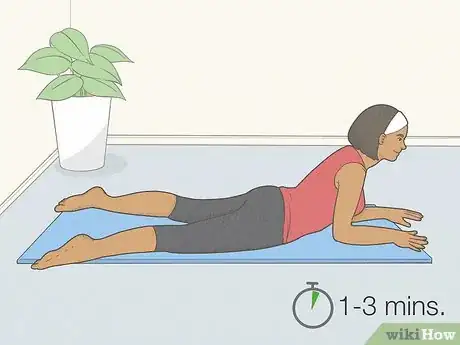
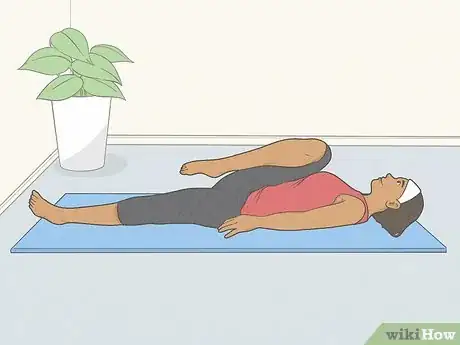
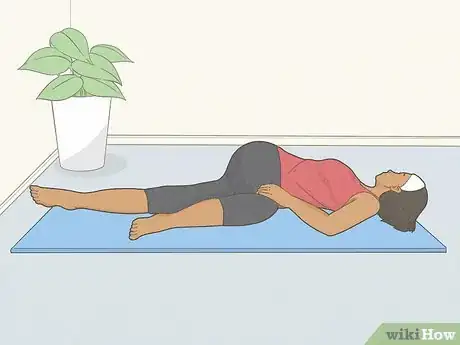
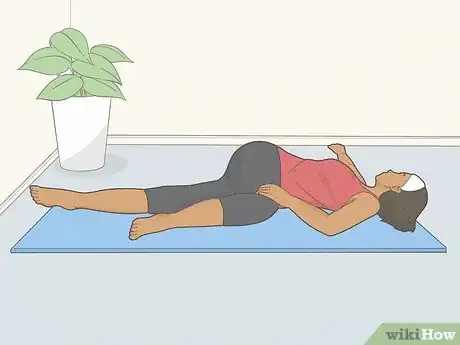
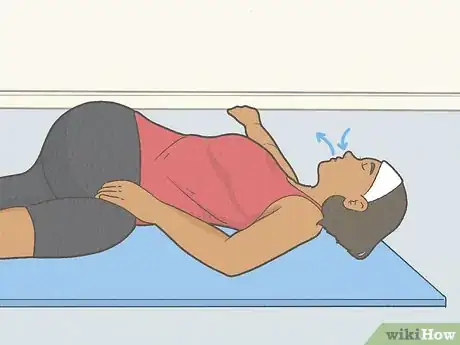
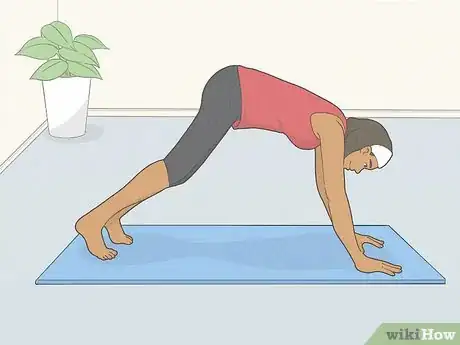
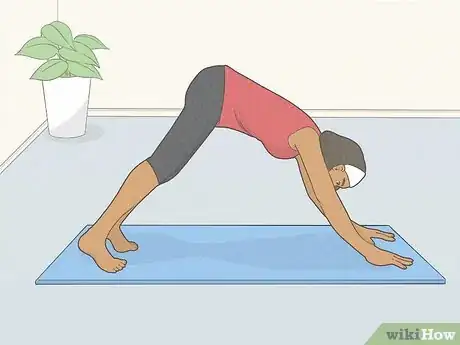
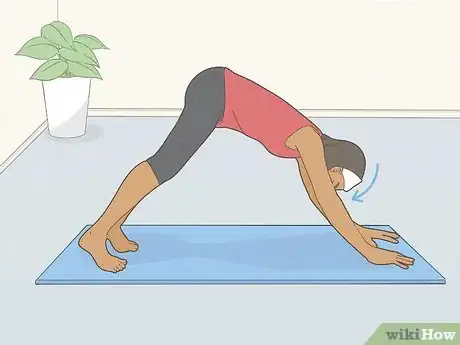
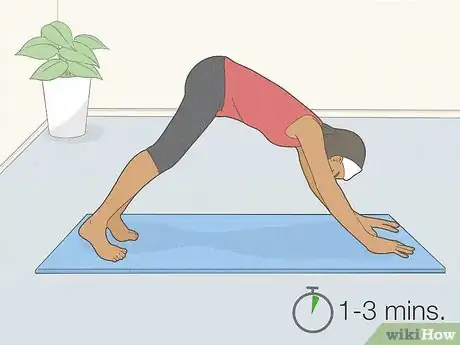
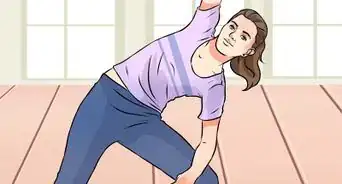



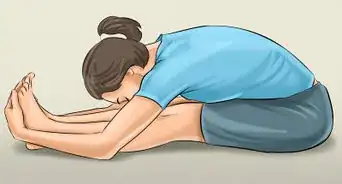





-Step-16.webp)








